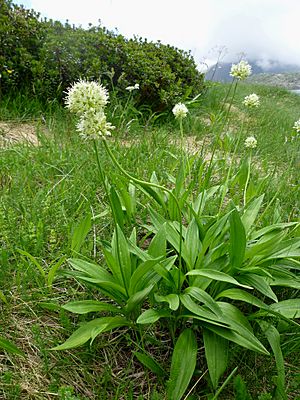Victory onion facts for kids
Allium victorialis, also known as the victory onion or Alpine leek, is a type of wild onion with broad leaves. It's a plant that lives for many years (a perennial). It belongs to the Amaryllis family. You can find it growing in the mountains across Europe and parts of Asia, like the Caucasus and Himalayas.
Some scientists used to think that similar plants in East Asia and Alaska were a part of Allium victorialis. However, newer studies show that these plants are actually a different species called Allium ochotense.
Quick facts for kids Victory onion |
|
|---|---|
 |
|
| Conservation status | |
| Scientific classification |
What Does It Look Like?
The victory onion usually grows to be about 30 to 45 centimeters (12 to 18 inches) tall. It has a special underground part called a bulb, which is like a thick root. This bulb is about as thick as a finger and 5 to 8 centimeters (2 to 3 inches) long.
Its leaves are wide and shaped like an oval or a spear. The flowers of the plant are a whitish-green color.
Where Does It Grow?
You can find Allium victorialis growing in many mountain ranges. It is common across Europe, especially in the mountains. It also grows in the Caucasus region and the high Himalayas in Asia.
How It Got Its Name
The scientific name victorialis comes from a German word, Siegwurz. This means "Root of Victory." The plant got this name because people used to believe it brought good luck. Miners in Bohemia, for example, would wear it as a charm. They thought it would protect them from bad spirits.
How People Use It
For many centuries, people in some mountainous parts of Europe grew Allium victorialis. They used it as a plant for medicine and also as a good luck charm. It was also recorded that the Ainu people in northern Japan ate this plant.
See also
 In Spanish: Victorial larga para niños
In Spanish: Victorial larga para niños


